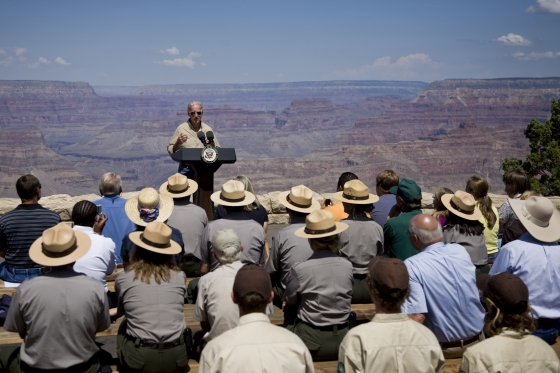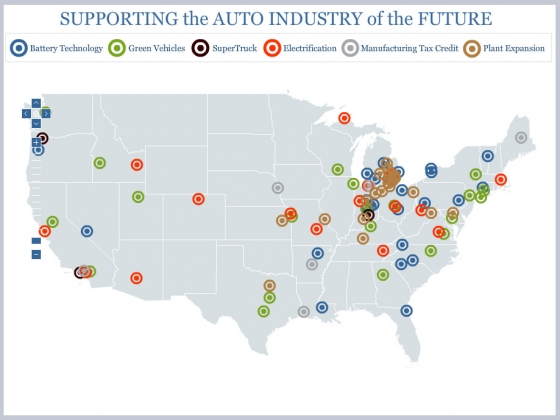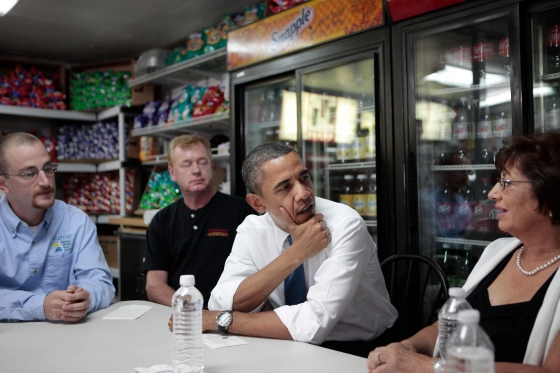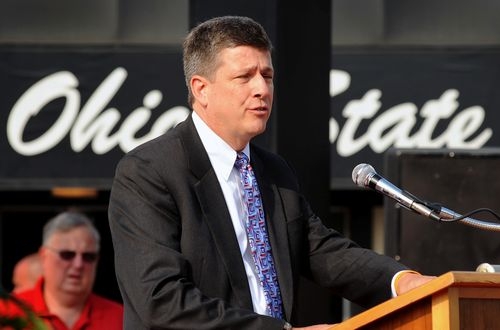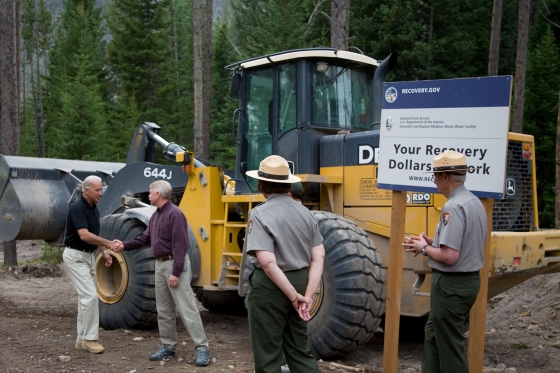-
President Obama praises the successes of the auto industry restructuring as good news for our economy, and calls on Republican leaders in the Senate to “stop holding America’s small businesses hostage to politics” by blocking a vote to help them create jobs.
-
July 30, 2010
04:45 PM EDTIn September 2009, the President announced that – for the first time in history – the White House would routinely release visitor records. Today, the White House releases visitor records that were created in April 2010. Today’s release also includes several visitor records created prior to September 16, 2009 that were requested by members of the public during June 2010 pursuant to the White House voluntary disclosure policy. This release brings the grand total of records that this White House has released to well over half a million records. You can view them all in our Disclosures section.
We note that January 2010 records were inadvertently posted twice. That error has been corrected.
Norm Eisen is Special Counsel to the President for Ethics and Government Reform
-
There’s no question that last year’s SAVE Award was a great success, with tens of thousands of ideas to help government save money and be more efficient submitted by Federal employees. It was a first-of-its-kind exercise, called for by the President, to tap into the knowledge of the people who know government first hand. As OMB Director Peter Orszag – who was integral to the SAVE Award getting off the ground – has explained, many of those ideas have made their way into reality through the Federal budget process.
This morning the opening stage of the second SAVE Award came to a close, and its success represented yet another big step forward in harvesting the wisdom and institutional knowledge of those working in government to save taxpayer dollars. Whereas in 2009, employees simply submitted their ideas into a web form – a “black box” of sorts – this year employees were able to not only submit ideas, but vote and comment on ideas from others, allowing collaboration and crowdsourcing to help bring the best ideas to the top, to continue developing ideas, and to demonstrate just how widespread a problem or opportunity really is. All told, there were more than 18,000 ideas posted, 164,000 votes cast, and more than 13,000 comments registered from just about every agency imaginable. And they’re all public, allowing everybody from taxpayers to agency heads to consider the ideas for themselves.
Over the coming weeks, OMB staff will be reviewing the submissions and picking some of the best and sharpest as finalists for a last round of voting by the public in September. The President has always said that change has to come from the bottom up, and there are few better examples than the SAVE Award.
-
Today the President was in Detroit visiting workers at a Chrysler plant and a GM plant that have not only survived, but found success after critics looking to score political points claimed there was no hope for them. For those critics the President offered a lesson: "Don't bet against the American worker."
During the two years since the economy took its hard downward turn, millions of Americans have had to fight with everything they had to stay afloat, to keep food on the table, to keep their businesses in business – and nowhere has that been more true than in Detroit.
The President has also been fighting alongside America’s workers – from the Recovery Act that’s saved or created about 3 million jobs, to the fight today over small business lending – and of course for the workers in Detroit and across America who contribute to the decades-old craft of American cars. When political opponents said that helping the American auto industry survive was a lost cause, and tried to turn public frustration against the President, he stepped in and made the hard choices anyway. There couldn’t necessarily be a life raft for everybody, but he was not going to let a million American jobs fall by the wayside simply because it opened him up for cheap political attacks.
-
July 30, 2010
02:30 PM EDTOn Tuesday, Vice President Biden continued his Recovery Summer tour at Grand Canyon National Park. Standing in front of the beautiful overlook at Hopi Point on the south rim of the canyon, we spoke with Roger Geiger, a construction worker who is helping to rehabilitate housing for the Havasupai tribe. Roger talked with us about how this particular Recovery Act project was helping him put food on the table and save for his children’s education.
-
The Affordable Care Act will strengthen the health care system for all Americans, but senior citizens in particular stand to benefit from the new law. And the Centers for Medicare & Medicaid Services (CMS) is getting a little help delivering the good news from a well known TV star: Andy Griffith.
Today, CMS released a new ad featuring Griffith discussing the Affordable Care Act. The ad will begin running immediately on national cable channels, and you can watch the ad now:
Viewing this video requires Adobe Flash Player 8 or higher. Download the free player. -
July 30, 2010
09:42 AM EDTIn a speech at the National Urban League yesterday, President Obama talked about the importance of getting students enthused about education and the particular importance of science and mathematics education.
Well, there is no better example of how to generate that kind of enthusiasm—all the while helping to make renewable-energy vehicles more practical—than the recently completed American Solar Challenge. Students from 13 universities in the United States, Canada, Germany, and Taiwan competed in the challenge, which requires students to design, construct, and then race a vehicle over 1,100 miles, powered only by the sun.
-
Today’s report shows that real GDP, the total amount of goods and services produced in the country, grew at a 2.4% annual rate in the second quarter of this year, the fourth straight quarter of positive growth. Growth in the first quarter was revised up to 3.7%, meaning that growth has averaged over 3% for the first half of 2010. This solid rate of growth indicates that the process of steady recovery from the recession continues. Nevertheless, faster growth is needed to bring about substantial reductions in unemployment. Much work clearly remains to be done before the U.S. economy is fully recovered. The comprehensive data revisions released with the report provide further evidence of just how severe the recession has been: the fall in GDP between 2007:Q4 and 2009:Q2 was 4.1%, making this the deepest recession since 1947
-
Every day, the Obama Administration is working to enforce America’s rights in the international trading system – to keep our workers on a level playing field in global markets, and ultimately create and sustain American jobs.
Over the past year, the Office of the U.S. Trade Representative has stepped up enforcement of our trade agreements using a range of options from negotiation to taking disputes to the World Trade Organization. These enforcement actions have helped workers in sectors ranging from agriculture to auto parts, from aluminum and steel manufacturing to aerospace construction.
Because President Obama took action to stem the tide of imported Chinese tires flooding the U.S. market, moms and dads are bringing home paychecks from tire factories in North Carolina and Arkansas. Because USTR successfully challenged Chinese industrial policy that pushed American auto parts suppliers to move production facilities offshore, men and women in Ohio and Michigan are still working on assembly lines. And because we took the European Union to court and won, the jobs of thousands of U.S. aerospace engineers and electricians in Washington State, Kansas, and South Carolina are more secure. And more American workers, from welders to widget-makers, will have a chance at future jobs on a more level playing field.
-
Thanks for checking out the West Wing Week, your guide to everything that's happening at 1600 Pennsylvania Ave. This week, walk step by step with the President as he fights for campaign finance reform, boosts small business, meets with Space Shuttle Atlantis astronauts, commemorates the 20th anniversary of the Americans with Disabilities Act, welcomes the 2009 Softball World Series champions, makes an appearance on The View and much more.
Find more video, photos, and information on the events featured in this episode below:
Monday, July 26, 2010
- The President speaks about limiting special interests and the DISCLOSE Act
- The President thanks Space Shuttle Atlantic astronauts
- The President commemorates the 20'th anniversary of the Americans with Disabilities Act
Tuesday, July 27, 2010
Wednesday, July 28, 2010
Thursday, July 29, 2010
Arun Chaudhary is the official White House videographer
-
Ed. Note: We encourage readers to watch the video of the signing, including the moving introduction from Lisa Marie Iyotte.
The President just signed the Tribal Law and Order Act -- an important step to help the Federal Government better address the unique public safety challenges that confront tribal communities.
According to a Department of Justice report, Native American women suffer from violent crime at a rate three and a half times greater than the national average. Astoundingly, one in three Native American women will be raped in their lifetimes. At the White House Tribal Nations Conference in November 2009, President Obama stated that this shocking figure "is an assault on our national conscience that we can no longer ignore."
Last week, Congress took another important step to improve the lives of Native American women by passing the Tribal Law and Order Act of 2010. The Act includes a strong emphasis on decreasing violence against women in Native communities, and is one of many steps this Administration strongly supports to address the challenges faced by Native women.
-
Today, President Obama delivered an address on education at the Urban League’s 100th Anniversary Convention highlighting the steps his Administration has taken over the past eighteen months to improve the education system in America. The President stated that education reform is a top priority for his Administration because the “status quo is morally inexcusable, it’s economically indefensible, and all of us are going to have to roll up our sleeves to change it.”
The President began his remarks by discussing the importance of education for the success of our economy and our nation:
I know some argue that as we emerge from a recession, my administration should focus solely on economic issues. They said that during health care as if health care had nothing to do with economics; said it during financial reform as if financial reform had nothing to do with economics; and now they're saying it as we work on education issues. But education is an economic issue -- if not “the” economic issue of our time.
It’s an economic issue when the unemployment rate for folks who’ve never gone to college is almost double what it is for those who have gone to college. It’s an economic issue when eight in 10 new jobs will require workforce training or a higher education by the end of this decade. It’s an economic issue when countries that out-educate us today are going to out-compete us tomorrow.
-
July 29, 2010
02:00 PM EDTOver the next week, the President will travel to Detroit and Chicago where he will meet with auto workers and tour plants of each of the big three auto makers. His trips offer an opportunity to take stock of where the industry stands this summer.
A little more than one year ago, the entire industry was on the edge of failure. Plants were being closed, jobs were being lost, and America’s future role as a leading producer of vehicles in the global marketplace was in question. We’re now starting to see real signs of recovery. While there is still a long way to go, the progress to date is far beyond what most observers thought possible a year ago. The industry is creating jobs and American auto companies are addressing past failures, restoring financial discipline and returning to profitability. Today, the White House released a new report cataloguing some of these early signs of success.
In addition to stabilizing the industry and addressing the hardship faced by communities that lost auto plants and the jobs they provided, the Administration has been focused on making long-term investments across the country that will make the U.S. a home base for the design and production of the next generation of innovative vehicle technologies. This new interactive map shows where these key investments have been made and the types of projects that will ensure the vehicles of the future are made in America.
Ron Bloom is Senior Advisor to Treasury Secretary Geithner and Senior Counselor for Manufacturing Policy
Ed Montgomery is Executive Director of the White House Council on Auto Communities and Workers -
July 29, 2010
11:23 AM EDTEach year, close to 100 workers are killed, and hundreds more are injured in workplace incidents involving cranes and derricks in construction. These incidents and their catastrophic impact on the lives of workers and families in America are preventable. For the first time in nearly forty years, the U.S. Department of Labor’s Occupational Safety and Health Administration (OSHA) has announced new rules to do just that.
Yesterday, after years of extensive research, consultation and negotiation with industry experts, OSHA announced the publication of a new rule covering the use of cranes and derricks in construction. This long overdue rule addresses the key hazards related to cranes and derricks on construction worksites, including the four main causes of worker death and injury.
-
Cross posted from the DOT blog.
Today was a great day to be in Colorado. First, I toured a Federal Railroad Administration facility--the work the FRA crew is doing there really deserves its own blog post, so stay tuned for that one next week.
Then, I learned about an exciting new municipal bike-sharing program in Denver with 43 bike stations and more than 400 bikes spread around the city. Mayor Hickenlooper and I even had a chance to test the system by checking out a pair of bicycles and riding them to another station.
But what really drew me to Denver was the Biennial of the Americas, a month-long celebration of the Western Hemisphere. I was there for the Americas Roundtable on Energy and Climate Change: Designing Answers for Today's Challenges and to discuss how DOT is working to manage those challenges.
-
For too long, too many Americans with pre-existing conditions were left out of the health insurance marketplace. Health insurance companies could charge these Americans more or simply refuse to cover them. But thanks to the Affordable Care Act, the health care system will no longer leave out the people who need care the most.
Starting September 23, the new law makes it illegal for insurance companies to discriminate against children under 19 with preexisting conditions. In 2014, discriminating against anyone with a pre-existing condition will be illegal, but we know Americans need relief now. That’s why the new law created the Pre-Existing Condition Insurance Plan. This plan offers coverage to uninsured Americans who have been uninsured for at least six months and unable to obtain health coverage because of a pre-existing health condition like cancer, diabetes or lupus.
-
July 28, 2010
07:09 PM EDTPresident Obama traveled to Edison, New Jersey today where he met with a group of small business owners at Tastee Sub Shop to discuss the economy and urge Congress to pass support for small businesses, the engines of private sector job growth. In his remarks following the meeting, the President spoke about the idea guiding the small business legislation that the Senate is expected to vote on this week.
The recession has meant that folks are spending less. It means that small businesses have had a tougher time getting credit and getting loans. And that’s why when I took office, we put in place an economic plan specifically to help small businesses. And we were guided by a simple idea: Government can’t guarantee success, but it can knock down barriers that keep entrepreneurs from opening or expanding.
-
July 28, 2010
06:41 PM EDTCross-posted from the U.S. Department of Transportation blog
Few things say summer like a state fair. And, as a graduate from the nearby University of Dayton, I was thrilled to take part in today's opening of the 157th Ohio State Fair with Governor Ted Strickland.
A proud Buckeye tradition, the Ohio State Fair has delighted locals and visitors since 1850. Last year alone, over 800,000 people turned out to take part in the livestock competitions, concerts, rides, and butter sculptures that make up a true state fair experience.
-
The New York Times ran a compelling piece today on a report written by Alan Blinder and Mark Zandi which found that the policy response to the economic downturn was “highly effective” and that without the fiscal stimulus and the financial measures the Administration and the Federal Reserve took last year there would be 8.5 million fewer jobs.
With the hard-fought passage of Wall Street Reform last week, the President ensured that Wall Street will be held accountable, and that the American taxpayer will never again be on the hook for their actions. As the President had said repeatedly, he was just as angry with having to take steps to shore up our financial system as all Americans were. But when the President came into office, the economy was falling off a cliff, and this report demonstrates just how deep and disastrous the valley below truly was had he not done everything possible to pull it back. The report particularly emphasizes the effectiveness of financial stability measures including the bank stress tests, the actions of the Fed and the TARP program and it highlights the potential cost to the taxpayers had policy makers not acted at all.
-
July 28, 2010
04:47 PM EDTEd. Note: Also watch a video of President Obama and his family's visit to Yellowstone National Park in the summer of 2009 along with some historical context.
On Monday, I joined Vice President Biden at Yellowstone National Park as he continued his Recovery Summer tour. Under overcast skies, we walked up a new gravel road to see the construction of the new Madison wastewater treatment plant, a $4.6 million project that will service the campground in this beautiful part of the park. This project replaces the weary wastewater plant, constructed in 1959, which was not built to meet today’s wastewater treatment needs or function throughout the year. The new design will be less visible from the main road and with its new treatment technology (better bugs as the project manager told us) no longer waft offensive odors over the campers. The work at Madison is being done by Dick Anderson Construction – a contractor based out of Bozeman, Montana. Ed Venetz, VP for the company spoke about how the ARRA funds have really helped keep his workers employed and how much he likes projects like this one in the National Parks. Ed later introduced the Vice President to a back drop of the Madison Valley and National Park Peak, the site of the legendary campfire where the idea of National Parks was born.
Watch all the musical acts








